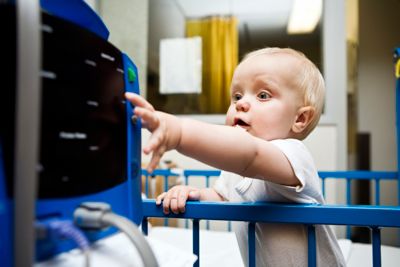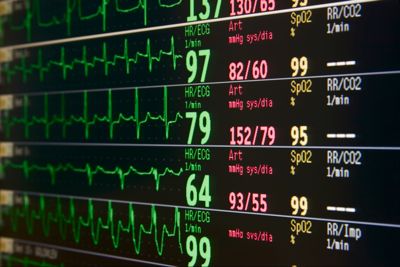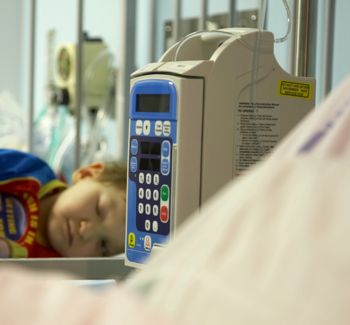A magazine where the digital world meets the real world.
On the web
- Home
- Browse by date
- Browse by topic
- Enter the maze
- Follow our blog
- Follow us on Twitter
- Resources for teachers
- Subscribe
In print
What is cs4fn?
- About us
- Contact us
- Partners
- Privacy and cookies
- Copyright and contributions
- Links to other fun sites
- Complete our questionnaire, give us feedback
Search:
DON'T press that button!
Doctors and nurses are there to save lives and most of the time that is what they do. Their job is tough, though, and if they make mistakes they can kill or seriously injure the people they are trying to save. Thousands of people do, unfortunately, suffer from mistakes every year. It's only a small number of those being treated but for the individuals and families concerned a mistake can be devastating. Many involve medical gadgets like the ones that release drugs through tubes to keep you alive or out of pain. At the end of the tubes there is a computer constantly controlling how much drug actually goes into your body.

Should we blame the doctors and nurses who make the mistakes? That is what often happens, but maybe it's not actually their fault. Perhaps, for example, those gadgets could be designed differently, designed in a way that makes mistakes less likely in the first place. Maybe by just looking for someone to blame we miss the chance to prevent similar problems in the future.
A new £ 6 million project called CHI+MED run by Ann Blandford, a professor at University College London, is going to tackle this problem. It aims to make a difference - a BIG difference. If it succeeds it will completely change the way medical devices are designed, bought and used so those mistakes are largely a thing of the past.
Ann is the director of the UCL Interaction Centre. It combines computer science and psychology research. She has a rather varied background, having originally studied mathematics and then worked in industry as a computer engineer before doing a PhD in Artificial Intelligence and then switching to cognitive psychology research. She combined that with her interest in computer science to become a world expert in Interaction Design. Building this highly successful career didn't prevent her from raising a family too: she has two, now grown up, daughters. Oh, and if you aren't impressed yet, she's also a rock climber in her spare time!

She will be coordinating a team on CHI+MED that also includes researchers from Swansea and two other London universities (City and Queen Mary) as well as hospitals in both cities, so she's going to be busy for the next 6 years. As she pointed out, though, the extra work is nothing compared to running a whole research centre!
So what can be done about all those mistakes? Well it's obviously crucial that medical gadgets are easy to use. The key is to understand why people make mistakes and then to design the gadgets so they both help people avoid making errors and help recover if things do go wrong.
The first thing to accept is that everyone makes mistakes. Have you ever got the wrong answer because you keyed the wrong things into a calculator? Now imagine those numbers you were typing in were setting how much painkiller a patient got. You are doing it lots of times every day with slightly different calculators and in different situations. You are being interrupted all the time. If you are a nurse and make a similar mistake to the ones you probably make all the time with calculators, you could very easily give someone an overdose. You must NEVER make the mistake. Try it from now on with calculators. From now on, don't make a single mistake using a calculator ... for the next 40 years or so. Are you up to the task?
Is it really that simple to make mistakes that kill though? Take the following example, based on a real hospital incident. A nurse was used to using a particular syringe pump (one of the gadgets that just pumps a drug into the person it's tubed up to). On this day she was using a different one to give a patient a dose of a drug. The second pump was from the same manufacturer and looked very, very similar, except there was a hidden difference in what certain identical-looking buttons did. With the first pump if you pressed the units button enough times it would cycle around the unit values: 8,9,0. She assumed pressing the same button on the second device did the same thing. It didn't. Instead, it cycled into the tens: 8,9,10. Neither of the two gadgets alert the nurses using them about what happens when the units button is pressed more than nine times: the keys beeps in exactly the same way. The result here was a big overdose of drug was given to the patient: out by a factor of 10. That can be enough to kill.
How is CHI+MED going to tackle such problems? Well an incident like this will trigger a cascade of different kinds of research. The team might find out about it from reading hospital or research reports, or from the team's own researchers who will be in hospitals talking to doctors and nurses about their jobs, watching operations, and so on.
A first step will be to create realistic simulations of both pumps that can be used in subsequent parts of the research. The team creating the simulations will investigate what other features are different and what are similar in this family of pumps, using mathematical tools to automate doing this. In the process methods and tools to analyse the designs will be developed with device designers. The aim will be to make it easier for them to do similar evaluations of their designs. That will help ensure the gadgets of the future don't have important inconsistencies in the first place.
As new inconsistencies come to light the team, working with the hospitals, will investigate more thoroughly what impact they could have in practice. Given the way the devices are actually used, could the differences lead to patients being harmed? That is all part of thoroughly understanding the situation that the gadgets are to be deployed in, something that is very important for any new IT system.

This kind of mistake made by the nurse, where someone follows familiar steps in the wrong situation is called a 'capture error', because your behaviour has been 'captured' by a habit. It is a well-known kind of mistake that people make regularly. You may have done it in telling someone your home phone number instead of some other you intended to tell them that just happens to start with the same area code, for example. The way our brains are wired makes us liable to do this kind of thing. The CHI+MED team working in the lab will study the causes of these capture errors and why they occur - what is going on in our heads to make us so likely to do it? Do interruptions, which are a fact of hospital life, make them more likely? Are they more likely if someone is trying to do two things at once, as nurses and doctors have to do? What kind of thing helps us avoid making this kind of mistake? Would different beeps at critical points be enough, or maybe having different looking buttons on the different devices? These experiments will involve people using the simulations of the devices doing real tasks, but in a lab.
The logicians involved in the project will meanwhile be creating mathematical models of the devices, of the human behaviour observed in the experiments and of the situations seen in the hospitals. They will run 'virtual experiments' where mathematical techniques are used to see what happens when the mathematical version of nurses use the mathematical version of the model in mathematical hospitals. The difference here is that the maths can be used to explore all possible things that might happen when people behave like the models not just those that do happen on a particular day. This can throw up yet new problems to study.
All of this work will be fed back to a team whose brief is to come up with new designs that avoid the problems discovered. The new designs will be investigated in all the same ways to ensure they really do fix things and don't just introduce new problems.
Of course the focus of all this activity won't be just on those two pumps from the original incident. The team in the hospitals will look for similar issues with other devices and that may lead to yet new activity. They will also talk to the people in the hospitals responsible for buying new devices and find out why they make the decisions they do, so that in future they can more easily tell which devices may lead to problems.
The approach for CHI+MED that Ann envisages will thus improve safety by a scientific approach to understanding and designing out errors. Modern science and engineering aren't about single subjects but about teams of people bringing different expertise. People like Ann who are experts in lots of subjects are invaluable for seeing the big picture and to be able to come up with projects like CHI+MED in the first place. If she has her way avoidable medical mistakes from poor interaction design will be a thing of the past.


